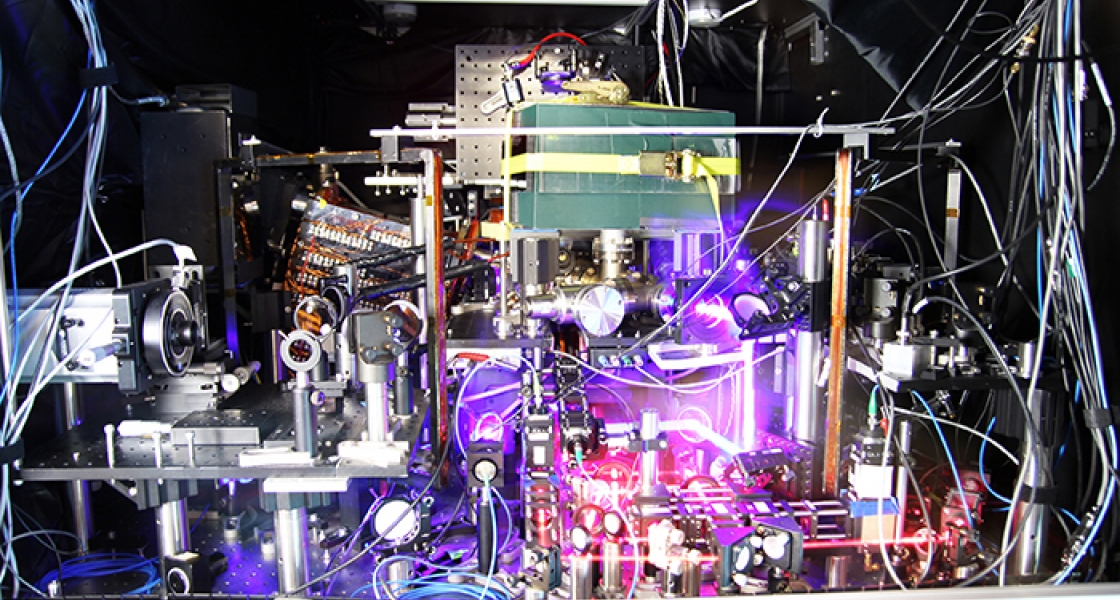The world’s most stable optical atomic clock resides in the Ye lab in the basement of JILA’s S-Wing. The strontium-(Sr-)lattice clock is so stable that its frequency measurements don’t vary by more than 1 part in 100 quadrillion (1 x 10-17) over a time period of 1000 seconds, or 17 minutes. This impressive result was obtained by lead graduate student Travis Nicholson, graduate students Mike Martin, Ben Bloom, Mike Bishof, and Sara Campbell, research associate Jason Williams, former senior research associate Matt Swallows, and Fellow Jun Ye.
The two key measures of atomic clock performance are stability and accuracy. A clock’s accuracy measures how well it keeps time against a mythical perfect standard. But all clocks are noisy, and averaging over time is necessary to reach the ultimate accuracy. Stability is a measure of how noisy a clock is, and thus how long the clock has to operate to achieve its ultimate accuracy. Recent research in the Ye group focused on improving stability. This work has now led to the Sr lattice clock being the most stable in the world by a large margin.
In addition to improved stability, the Ye group continues to rapidly improve the accuracy of the Sr lattice clock. The most accurate clocks in the world are currently clocks based on single trapped ions of Al+ or Hg+ at the National Institute of Standards and Technology (NIST) in Boulder. But the Ye group’s Sr-lattice clock is about 40 times more stable than the NIST Al+ clock (i.e., the Sr lattice clock reaches its ultimate accuracy in a much shorter time).
The two main sources of noise or jitter that limit stability in optical atomic clocks are clock laser noise and quantum projection noise, which comes from not being able to measure the exact quantum state(s) of the atoms at the heart of these devices. This uncertainty is due to the laws of quantum mechanics.
Until recently, the Sr-lattice clock laser was the dominant source of noise in the Ye group’s optical atomic clock. However, Martin has now built a new ultrastable clock laser that has been shown to have the world’s best performance (with a stability of 1 x 10-16 from 1 to 1000 s). The new laser has greatly improved the clock’s overall stability. It has also turned attention towards the reduction of quantum projection noise.
Quantum projection noise cannot be entirely eliminated, however. A certain amount of fluctuation in quantum measurements is intrinsic to any system where the laws of quantum mechanics predominate. This amount of intrinsic “noise” is known as the quantum projection noise limit. The stability of the Ye group’s Sr-lattice clock is now within a factor of two of this quantum limit.
One reason the Sr-lattice clock is more stable than ion clocks is that the Sr clock contains thousands of atoms. The quantum fluctuations of these atoms tend to average out, reducing the overall quantum projection noise of the clock. In contrast, the ion clocks have only a single ion, which constantly flips back and forth between quantum states. With only one particle instead of thousands of particles, it takes a lot longer to average down the intrinsic quantum fluctuations.
The Sr-lattice clock’s new laser is an important reason for the recent improvement in its stability. And, the clock will continue to improve with a more stable laser because the group has figured a way to increase the number of atoms when necessary.
Regardless of the details, however, the new stability value is particularly exciting for the Ye group and optical atomic clock developers around the world. It is the first time a neutral atom-based clock has bested the top-performing trapped single-ion clocks in a key measurement of clock performance. This improved stability will facilitate the group’s current efforts to continually improve the Sr lattice clock accuracy. — Julie Phillips




